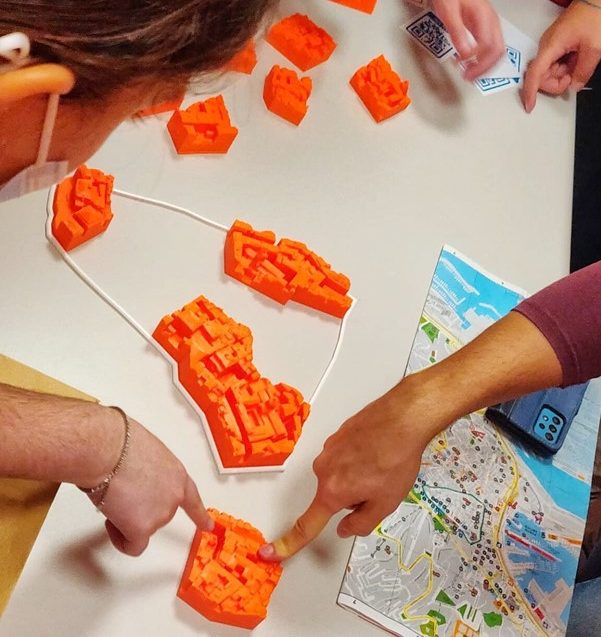Reading Time: 10 minutes
Changing society through cultural heritage
From sustainability to social inclusion and economic resilience, the benefits of cultural heritage are multiple, and cities are leveraging it to create a better society for people.
From sustainability to social inclusion and economic resilience, the benefits of cultural heritage are multiple, and cities are leveraging it to create a better society for people.
Recovery and resilience
Cultural heritage has significant potential to aid the recovery and resilience of cities and regions after the Covid-19 pandemic, which is a key priority for mayors in 2023, as identified in the results of the Eurocities Pulse Mayors Survey. Cultural heritage institutions (libraries, museums, galleries etc.) can engage in dialogue around contemporary events and co-produce new knowledge and narratives with diverse communities to help build more inclusive and sustainable societies.
Cities can strengthen their cultural heritage management strategies based on disaster prevention and response. During the Covid-19 pandemic, cities enhanced creativity to deliver new cultural offerings and services, from concerts to street performances, which were accessible to all and held outdoors. The Cultural Heritage in Action project has also provided evidence of the role of heritage in addressing other EU policy priorities, such as enhancing cultural participation and the role of culture in society.
Many cities have developed apps that can improve economic outcomes of the cultural sector by encouraging locals and tourists to explore cultural offers off the beaten track. This can enrich diverse communities, both financially and in terms of their sense of local pride, foster more awareness of climate change and the natural world, and encourage longer stays among tourists. In Florence, the FeelFlorence app suggests unusual itineraries to bring visitors closer to local experiences and avoid over-tourism in central areas of the city. The app gathers information and promotes new paths and experiences outside traditional tourist areas.
Cities are under increasing pressure to meet statutory demands, ever-growing costs for cultural organisations, and cost of living challenges for our citizens. But a vibrant and sustainable cultural offer remains a significant social and economic driver for cities, more than ever in times of hardship and challenge.
– Cllr Ian Ward, Leader of Birmingham City Council
Governance and financing
The challenge of demonstrating the economic potential of cultural heritage remains, especially in a post-pandemic economy where public budgets are strained. Cities and regions must balance economic, social, cultural, and environmental needs to ensure the sustainability of tourism and cultural heritage. Cultural institutions also need to engage with local people who are not reached by traditional educational and social activities.
Stories from cities across Europe show how they are using cultural heritage to strengthen communities and holistically boost other sectors, as well as experiment with new ideas. As mentioned above, cultural heritage drives local economic development. To keep the distinctive character of Lisbon, for example, preserve its commercial and trade heritage and revitalise the urban fabric, the municipality set up the programme Lojas com História (Shops with a history). This pioneering programme aims to safeguard the remaining retail stores with unique commercial activities, the history of which is intertwined with the city. Shining a light on traditional shops and their owners allows the administration to fight property speculation while preventing the unrestrained increase of rents on retail units.

Sustainable development
Cultural heritage is an essential component for local sustainable development. Cities and regions can leverage cultural heritage to drive a new green and sustainable economy by bringing environmental sustainability and action on climate change into cultural heritage activities. The involvement of local people in shaping their environment and cultural heritage is important to engage and empower them. However, public finances are often overstretched, and cultural heritage organisations are required to develop new revenue streams to diversify their incomes.
In Reims, the strength of culture for environmental sustainability is evident in the ‘Museums Go Green’ programme, a grassroots initiative from local museums that is supported by the city. Started in 2022, the plan includes structural work on museum buildings, new approaches to their collections, artistic commissions and temporary exhibitions to raise awareness about climate change and environmental sustainability.
When an exhibition or performance ends, a lot of material is left over or thrown away simply because of a lack of space. In Stockholm, the old premises of the Pripps brewery have become a large material warehouse for reusing props. The Material Storehouse is an innovative project on sustainability and recycling run by several cultural institutions and museums which decided to share their and reuse their materials.
Today, Lille’s plan for climate includes culture. The issue of climate change is a question of international solidarity and cooperation. We don’t have the choice and we must act.
– Marie-Pierre Bresson, Deputy Mayor for Culture at Lille Metropolitan Area
For low carbon and more inclusive culture
Arts and culture are a powerful lever to support positive change. Nevertheless, cultural and artistic activities consume energy, resources and materials and can also generate several types of pollution. Cities understand and share the urgency for action to meet the ecological imperative through all their public policies, including those on culture.
After dedicating the Eurocities Culture Forum 2022 in Lille to how culture can be sustainable, the Eurocities task force on Sustainable Culture has produced the ‘Eurocities Lille Call to Action for low carbon and more inclusive culture.’
The call to action was officially launched at the Brussels Urban Summit 2023 and cities can express their commitment by signing it.

Participatory governance
Cultural heritage is also a useful vehicle for participatory governance, for example to co-design cultural policies, share management and safeguarding of heritage, and increase awareness and valorisation of cultural heritage in communities. However, cities face challenges in achieving participatory governance of cultural heritage, such as weak community ownership of cultural heritage and difficulty in engaging with different audiences. Local governments, however, actively facilitate cooperation between local actors.
When Vantaa realised that traditional urban cultural programmes from the 1990s no longer fit, mostly due to the lack of residents’ support, a narrow policy approach to cultural environment and lack of monitoring and evaluation, they decided to take another path and started working on a new Cultural Environment Programme. The municipality engaged residents through projects and exhibitions led by local people, digital tools, local newspapers and questionnaires to develop the new programme. The result takes into consideration stories, feelings and memories of the local cultural environment.
Our Cultural institutions reach up to two million people, we should take advantage of that outreach.
– Matti Helimo, Deputy Mayor for Culture at the City of Tampere
Adaptive re-use of heritage buildings
Adaptive reuse of heritage buildings has become a popular approach for local authorities seeking to revitalise historic or industrial buildings while providing a new use to the community. Nonetheless, this approach also faces challenges in incorporating ecological, environmental, and social uses.
In 2022, the municipality of Genoa launched Rolli Lab, an open call for innovative ideas to enhance the value and public use of the Rolli palaces in Genoa and improve the city’s cultural life. The initiative has raised awareness on the value of heritage for the cultural and socio-economic wellbeing of the city and will be repeated annually.
For example, it created a treasure hunt taking visitors through heritage trails in the city and it launched a new service to improve the conservation of the Rolli palaces, to facilitate monitoring of their condition and to raise awareness about the effects of climate change on historical buildings.
Across Europe, cities are using adaptation of disused heritage buildings to foster economic development and cultural innovation. In Helsinki, Kaapeli is a limited real-estate company that converted the former Nokia Cable Factory into a cultural centre back in 1991. While the building belongs to the city, the centre has evolved over time and is a mixed venue, today consisting of 63,000 m2 of space, used by 130 ateliers, two bars, 12 galleries, three museums, two restaurants, multiple event venues and a brand-new dance house with two halls. The building is accessible during most times of the day and night and is very much a model for new kinds of open use of buildings.

Quality of interventions on heritage buildings
Cultural heritage is also a strong tool to address societal issues such as sustainable development, social inclusion, and community empowerment. Cultural and creative sectors can play a significant role in driving sustainable recovery by co-producing new knowledge and narratives with diverse communities and the engagement of local people.
Making heritage more sustainable can lead to conflicting situations between, for instance, preserving heritage aesthetics and working out how to make sustainable upgrades on windows and walls, and even placing solar panels on the roof of a building. To prevent conflicting situations and better provide information on sustainable solutions applicable to cultural heritage, the city of Amsterdam created a digital counter, which is accessible to all.
By giving information about the buildings in protected heritage areas, the Counter for Heritage and Sustainability facilitates sustainable initiatives from residents and organisations on cultural heritage. It also provides booklets and handouts translating sustainability and heritage policies into easily digestible information for locals.
Adaptive reuse of heritage buildings, participatory governance, financing, sustainable development, resilience, recovery from the pandemic, and high-quality interventions in built heritage are all important tools for strengthening our societies and achieving European and local goals. By leveraging the power of cultural heritage, cities can create vibrant, sustainable, and inclusive communities that are resilient to the challenges of the future.

Tools from Cultural Heritage in Action
These are just a few of the 60 case studies collected through Cultural Heritage in Action.
The project also produced an online publication highlighting challenges and trends of cultural heritage in Europe.
